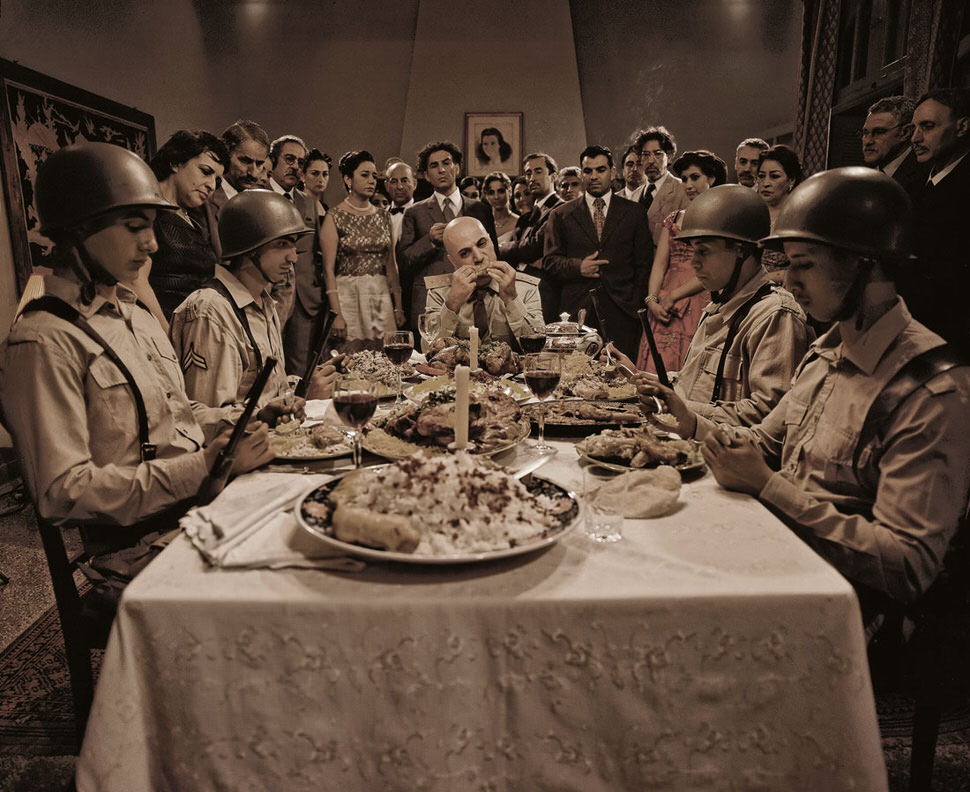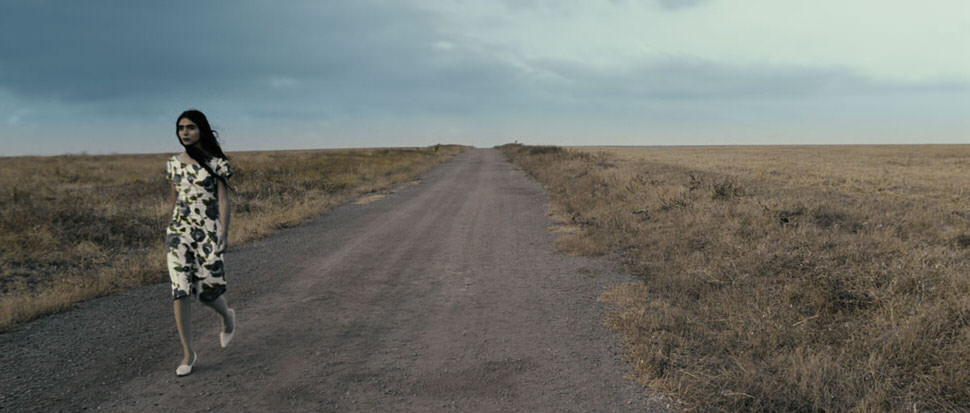Women Without Men is the Iranian-born artist Shirin Neshat’s first feature-length film, and also her first intended for viewing in theaters. But Neshat is well known in the art world for a series of shorter art videos she began making in the late 1990s. Among the most acclaimed of these is Turbulent, her take on the prohibition in Iran against women singing in public. In it, an Iranian man (in life an Iranian-American artist, and the partner of Shirin Neshat) faces and sings into the camera, his back to an auditorium of fellow men. Opposite him on a split screen a woman starts to sing—alone, in a darkened and emptied hall, and from what seems to the viewer a fiercer corner inside her soul. In another of Neshat’s videos, Rapture, a group of men congregate near a wall while a group of women in chadors head toward the sea with a small, rickety boat. Not having seen Neshat’s videos in the installations where they were originally shown, I watched Turbulent online and have pored over a new Rizzoli edition about her work, with commentary by Neshat and an introduction by Arthur Danto. The book charts her earlier, provocative photography. But mainly it reviews her video work, with many arresting stills.
Neshat’s own comments confirm the viewer’s sense that the conceptual terrain that interests her tends toward the kind of framing that poses “the problem of…”: as in “the problem of women in the Islamic public sphere,” or the problem of heroism and martyrdom, or of Islam and Christianity in the modern global world. The insights gleaned from this approach do not seem necessarily revelatory. But Neshat’s execution generates more suspense—there is a challenging sensuality in the faces she captures; and with her interest in the visual shape of stories, she has access at times to structures of myth. Also, she has a strong composing eye—her groupings of people are beautiful.

Women Without Men adapts a well-known 1989 Iranian novel by Shahrnush Parsipur (a new English translation was published in 2004). The novel has been described as magical realist—true as far as it goes, but not too helpful to understanding it. It is a sequence of stories about five women, a couple of them with strange or inexplicable fates. (The first, absent from the film, wills herself to become a tree; another returns after her death as a mind-reading ghost—yet a ghost physically real enough to be raped.) Parsipur writes with the surface simplicity of a tale-teller. But she drops in prosaic, stinging touches of realism—of gossip, envy, suppressed thoughts and misunderstandings. These moments are both sadly comic (a man, beholding a woman who pathetically hopes he’ll marry her, secretly thinks to himself how ugly women look when they squat) and gracefully brutal. Asked by a truckdriver where she and a friend are headed down the highway, a woman—the same one above, who squatted and hoped—answers,
“We’re going to Karaj to reap the benefits of our toil and get rid of the men who control us.”
The driver laughed heartily and said, “Oh really, is that so?”
He pulled off her chador. She cried out for help. After a brief struggle, the women were overcome.
In passing dialogue, but memorably, Parsipur picks over the wound to women (a wound they sometimes willingly transmit to others) caused by the toxic Iranian obsession with virginity. Parsipur had been imprisoned before—according to an afterword by Persis M. Karim, for protesting the Shah’s execution of poets and for her brother’s attempts to gather a political archive. The taboo-break of her writing on virginity and women’s sexuality sent her back to jail twice and lead to her publisher’s imprisonment. She eventually began to travel more abroad, and finally settled in the US in 1994.
Parsipur’s abstractly symbolic yet personal, bold yet delicate book must have been daunting to adapt. In any case, Neshat and her co-writer have tweaked the situations of several characters, adjusting some of their decisions and fates—perhaps more than they needed to. Much clearer is Neshat’s decision to take the vaguely sketched backdrop of the novel’s intertwined stories and make the charged political atmosphere of 1953—during the summer of unrest leading to the Anglo-American engineered overthrow of the elected leader Mossadegh, a move fatal to Iran’s democratic future—one of the film’s major threads.
For anyone who followed the brave student protests this past year in Iran, the invitation to imagine the country at this crucial crossroads is welcome. To make the film, Neshat had to restage the 1953 protests in Casablanca. We hear radio reports on the British boycott and see headstrong supporters of Mossadegh marching to the square, matched on the next street over by a crowd of opponents; we see parties among the well-off visited by the crisp-uniformed military who will flourish when the Shah retakes the reins. “And in this turbulence and noise, there was almost silence underneath,” says one of the main characters, “the sense that everything repeats itself over time. Hope, betrayal, fear.” Perhaps the treatment can’t help but feel telescoped, a coup captured from afar and in shorthand, with the odd result that instead of being drawn deeper into the Iranian scene one is reminded of broad family resemblances to struggles around the world at that time that set workers or peasants or students against crisp-uniformed military men doing Western salutes.
Advertisement

Neshat’s beautiful images, and also her sounds, remain a clear strength over her plotting. As in Turbulent, she casts a spell portraying musicians at weddings and salons. In another short but fierce scene, women in black sitting cross-legged in a courtyard are swaying as they wail, their voices fused into a buzzing sound like a medieval shawm. The film keeps returning to the image of a walled garden outside Tehran that is also key to the novel, a temporary place of refuge for the women and a thematically loaded idea. The first time we glimpse the garden, it looks like little more than a scrawny ribbon of stream water. But soon enough tall trees come into view, and fog cut by stripes of sunlight. There is an orchard nearby and there are plants, not overly tended by perfecting human hands and gone to seed. Visually the scene has magic in it—a quiet dense with the work of nature, a paradise saturated with the energy of life, cycling toward death and back again.
Women Without Men, directed by Shirin Neshat, opens Friday, May 14, at New York’s Quad Cinema and is playing in other cities throughout the United States; the book on which it is based, Shahrnush Parsipur’s Women Without Men: A Novel of Modern Iran, is available in paperback from The Feminist Press at CUNY. A catalog of Neshat’s work, Shirin Neshat, with an essay by Arthur Danto and a forward by Marina Abramovic, was published by Rizzoli in April.



